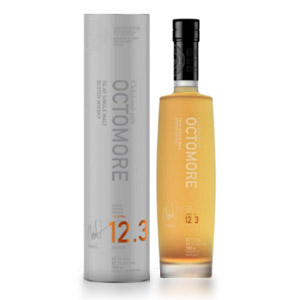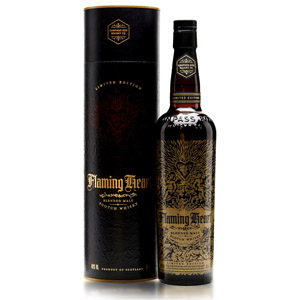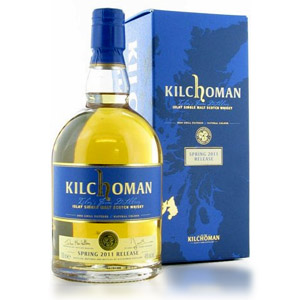(Note, this is part three of a three-part series of reviews. Start here.)
12.3 this year was distilled in 2015 from the 2014 harvest of 100% Islay-sourced Concerto barley from Octomore Farm grown by “The Godfather of Soil” James Brown. The barley was shipped to Inverness to be malted by Bairds to 118.1 ppm, which is slightly lower than the other two 12.x releases this year. Although it is cask strength, Bruichladdich mixes in a “just a drop” of spring water from Octomore Farm’s natural spring, which does not significantly change its strength at a whopping 62.1% ABV.
The maturation for this one was a little complex, so let me try to break it down: A full three-quarters (75%) of the distillate was aged for 5 years in first-fill American oak ex-bourbon barrels. This gives the whisky structure. The other quarter (25%) was matured for the full 5 years in first-fill PX (Pedro Ximénez) sherry casks from Fernando De Castilla in Spain. The two batches were then married together in neutral casks before being bottled.
Sherry aging is uncommon at Bruichladdich unlike other distilleries, and it was refreshing for me to hear the reason out loud from head distiller Adam Hannett on our group call for the Octomore Twelve campaign. He said that Bruichladdich decided to discontinue sherry aging years ago when they found they couldn’t get any true sherry casks from the open market. Everything they received was sherry “seasoned” (meaning some sherry-like liquid was sloshed around inside an ex-bourbon barrel) and of disappointing quality. In 2007 the distillery entered into a relationship with boutique bodega Fernando De Castilla, which uses American oak barrels in a traditional solera system for aging its wines. Bruichladdich gets the bodega’s casks when they are finished in the solera, including PX, oloroso, moscatel, and occasionally palo cortado casks. Hopefully this will result in more sherry-matured whisky coming out of Bruichladdich in the next few years.
The x.3 bottling is always intended to be the “Octomore of Octomore” expression, with as many of the ingredients and processes as possible originating on Islay itself. Someday, if plans for the distillery’s new maltings get underway, x.3 may even be malted on Islay.
Nose: Red fruit-flecked peat smoke: ripe red plums, raspberry white tea, fig preserves. Deeper in the glass I find dark chocolate, dark-roast coffee beans. The peat smoke is well-meshed with the sherry notes, with neither overwhelming the other.
Palate: Medium-bodied. Heavy tongue burn (of course), which is followed by tart cherry pie filling, chocolate fudge, and smoky toasted nuts.
Finish: Long. The roasty notes continue on through the finish, along with now-slightly-bitter barrel char and spent campfire smoke. Fades slowly.
With Water: Several drops of water add a rounder sweetness to the aroma, turning red fruit into fruity baked desserts, including strawberry shortcake. The peat smoke seems muted, but comes back on the tongue. The finish seems clearer, with a more-vibrant red fruit note. As usual, try this without water first and then add a little to see how it changes.
Overall: A vastly different beast than the 12.1 and 12.2. The smoke profile is the same (although I notice fewer maritime notes), but the interplay between fruity sherry and smoke reveal a whole new class of flavors, including a range of toasted/roasted notes between nuts, cacao, and coffee. Downright beautiful, and probably my favorite of the three Octomore 12s.
(Note: I’ve marked all three Octomore bottles as “Must Try” this year, but really I just mean you’ll enjoy any of them if you can get your hands on them. No need to buy all three unless you’re independently wealthy or just that devoted to Bruichladdich!)


About The Distillery
An Islay distillery of another sort, Bruichladdich (“brook laddie”) or “The Laddie”, is now known for bucking the trend. In an era of more and more heavily-peated island whiskies, Bruichladdich produces a mildly-peated whisky with character derived more from oak and barley varieties than peat. Bruichladdich captured the hearts of craft whisky adherents with its rebellious approach to revitalizing the distillery after its 2001 reopening, producing numerous fancifully-named one-offs using maturing stock inherited from the previous owners, who mothballed it in 1994. It used these stocks to raise money each year until its ten year-old official bottling was ready. It also began marketing heavily-peated spirit under the name of nearby closed distillery Port Charlotte. Soon thereafter in 2012, however, it sold (or sold out?) to multinational spirits conglomerate Rémy Cointreau. The distillery’s process water rises through stone veined with iron, and runs over peat bogs. All Bruichladdich releases are of natural color and are not chill-filtered.









I wonder about the sherry cask issue. I have spent time in Jerez Spain. It is my understanding that there are literally no sherry solera casks sold to the scotch industry that are not seasoned. The barrels used at the bodegas are absolutely as old and inert as the can find. The solera casks are frequently 100-150 years old. They are used until they can no longer hold wine. There can be some old casks from bodegas that went out of business but they usually go to other bodegas that need to replace barrels or expand their aging facilities. Additionally, they are all made from American oak.
I wonder if Adam H is misinformed (doubtful considering his knowledge, position, and skill level), or has a super secret stash of barrels somewhere. Since you are on the inside of the octomore experience, perhaps you could ask him?
What he told us (and is described in the linked content above) is that they have established a special relationship with a small, boutique bodega in Spain (Fernando di Castilla). Bruichladdich gets their used solera casks. I very much doubt that Adam would have lied to our (virtual) faces, so I don’t have any reason to doubt him. My guess (??) is that the bodega recognizes Bruichladdich’s desire for “real” sherry casks (note that “traditional” sherry-cask aging of scotch was performed in sherry shipping/storage casks, not solera casks) and so they intentionally rotate barrels out of the solera for the purpose of reselling them. They are indeed American Oak. I don’t know if the bodega uses raw American oak casks or if they get ex-bourbon like everybody else.
I believe raw due to the different size casks for sherry. I didn’t see any bourbon casks there or bourbon stamps on sherry cask barrel heads. They have to put sherry into them a few times to reduce the tannin levels to use in a solera. Interesting about the solera casks in regards to bruichladdich. Perhaps the bodega decided to do that in their business plan and swap them out. I haven’t been to that bodega specifically, but the others considered their solera casks as pure gold that they would never sell.
Looks like he is correct
https://www.whiskynotes.be/sherry-casks-in-the-whisky-industry.pdf?pdf=sherry-casks
Great article! Thanks for linking.